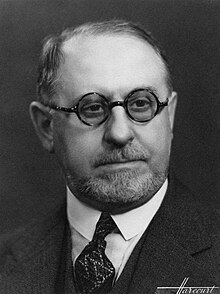You can help expand this article with text translated from the corresponding article in French. (June 2016) Click for important translation instructions.
|
| Paul Jouve | |
|---|---|
 |

Pierre-Paul Jouve (Marlotte, Seine-et-Marne, 16 March 1878 – Paris, 13 May 1973) was a French painter, sculptor and illustrator. He was notable for his paintings and sculptures of Africa's animals. He was first recipient of the Prix Abd-el-Tif in 1907, and later of the Prix d'Indochine in 1921.
Biography
Paul Jouve was two years old when his father set up his ceramist workshop on Boulevard Saint Jacques in Paris. It is in this artistic universe that he grew up playing with colors, modeling the earth, pampered by his young mother, who dreamed of making a teacher of her. Very early on, his father, seeing his passion for drawing, encouraged him, introduced him to the Jardin des Plantes, where he developed a passion for the big cats that he practiced drawing.
For the Universal Exhibition of 1900, the architect Binet, commissioned a frieze of wild animals of more than 100m representing tigers, bears, lions, bulls, and mouflons. This frieze will be executed in greenish brown glazed flamed sandstone by the sculptor Alexandre Bigot. Binet also ordered four lions from him to decorate the main gate of the Champs Elysees, between the two palaces, and a monumental statue representing a rooster wings outstretched in the center of the gate.
In 1907, Jouve was awarded a scholarship from the General Government of Algeria, and along with Léon Cauvy he was the first resident of Villa Abd-el-Tif in Algiers. The Contemporary Book Society commissioned him to illustrate Rudyard Kipling's Jungle Book, which was not published until 1919.
Winner of the General Government of Indochina travel grant, he is preparing a major trip to the Far East. In 1922, at the end of the summer, painter on a mission representing France, he embarked in Marseille, for a long journey of eleven months which will lead him successively to Indochina, China, Ceylon, then to India. He will stay in Angkor for nearly three months, fascinated by the beauty and grandeur of the site. He will bring back from this trip hundreds of studies which will serve him among other things to illustrate, Le Pellerin d'Angkor by Pierre Loti.
Gallery

References
- Lynne Thornton Les Africanistes: peintres voyageurs, 1860-1960 1990
- "Paul Jouve".
- Guégan, Stéphane (8 September 2005). "Pierre-Paul Jouve. Peintre, sculpteur animalier". La Tribune de l'Art (in French). Retrieved 17 October 2021.
- Félix Marcilhac, Pierre-Paul Jouve. Peintre sculpteur animalier, Les Éditions de l’Amateur, 450 p., 98 €, ISBN 2-85917-409-5
- Marcilhac, Felix (2005). Paul Jouve peintre sculpteur animalier (in French). Paris: Les Éditions de l'amateur. ISBN 978-2859174095.
- Eludut, Christian (2007). Le monde Animal dans l'Art Décoratif des Années 30 (in French). Paris: Edition BGO. p. 6. ISBN 978-2-9529802-0-3.
- Vidal-Bué, Marion (2003). L'Algérie du sud et ses peintres, Southern Algeria and its painters (in French). Editions Paris Méditerranée. ISBN 978-2842721756.
- Paul JOUVE (1878-1973) Pierre Loti’s A Pilgrim from Angkor, 1930. Edited by Paul Jouve and F L Schmied, in Paris. Illustrations by Jouve, wood engraving by F.L Schmied
- "Paul Jouve".
External links
- Paul Jouve in American public collections, on the French Sculpture Census website

This article about a French artist is a stub. You can help Misplaced Pages by expanding it. |
- 19th-century French painters
- French male painters
- 20th-century French painters
- 20th-century French male artists
- French animal artists
- French painters of animals
- Animal sculptors
- 1878 births
- 1973 deaths
- 20th-century French sculptors
- 19th-century French sculptors
- French male sculptors
- 19th-century French male artists
- French artist stubs